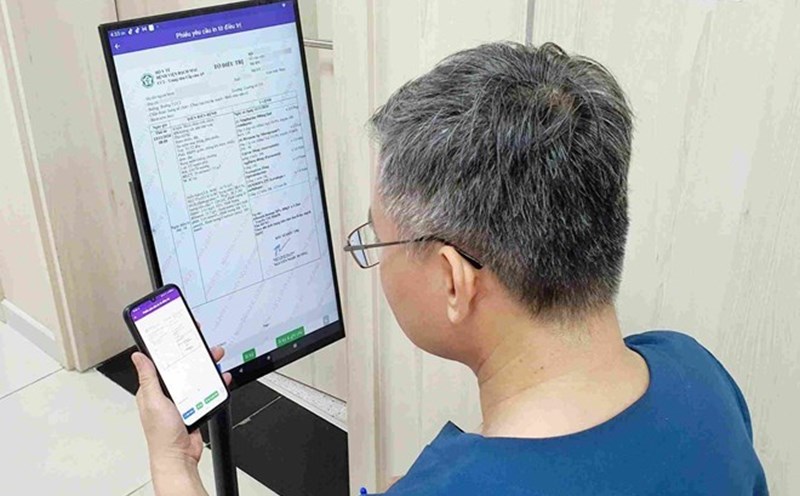Electronic medicine is still just a cry for help
The Ministry of Health has launched a project to build a national electronic prescription management system, but so far, the progress is still very sluggish. Some localities are piloting, but the data is not connected between hospitals, private clinics and pharmacies.
Meanwhile, in many countries, each prescription is stored electronically, attached to a patient identification code. Pharmacies can only sell drugs after system authentication, helping to prevent "unwritten sales". In Vietnam, the lack of technical mechanisms and requirements makes this process impossible to put into practice.

A pharmaceutical expert commented: A obvious weakness is the lack of data connection and responsibility between parties in the management chain. The doctor prescribes, but there is no mechanism to monitor whether the drug is purchased properly or not. The pharmacy sells drugs, but is not bound by the verification system. The management agency that wants to check also does not have data for comparison.
When the parties operate disjointedly, control becomes a form. Some doctors even prescribe emotional prescriptions, while pharmacies make profits and make a profit. As a result, patients can easily buy prescription drugs and then many consequences can occur.
Dr. Ta Manh Hung - Deputy Director of the Department of Drug Administration (Ministry of Health) - said: Although all pharmacies are currently connected to software connected to the National Pharmaceutical System, the control of prescription drugs is still difficult. No one verified whether the prescription was valid, what the patient had purchased, what drugs were missing or how long he had used them.
According to Mr. Nguyen Huu Trong, General Secretary of the Vietnam Medical Informatics Association, buying prescription drugs is too easy, while paper prescriptions cannot help authorities control the situation of prescription drug sales. Pharmacists at retail establishments often arbitrarily sell prescription drugs without authority, while people buy and use drugs themselves based on personal experience or drug prescriptions of others, without paying attention to important factors such as disease, weight, and age.
The national information system for managing prescriptions and selling prescriptions is built to connect all prescriptions from public and private medical facilities nationwide. Each prescription is attached with the identification code of the doctor, medical examination and treatment facility and a separate prescription code, stored in the general store of the Ministry of Health.
When patients come to drug retail facilities, the system will share the prescription (with the patient's consent) with the pharmacy's software to compare, sell drugs according to the prescription and record the quantity of drugs distributed. This method helps prevent the situation of non-transparent paper prescriptions, buying drugs many times with an expired prescription or a used prescription. According to Circular 52/2017/TT-BYT, the prescription is only valid for 5 days.
100% of pharmacies have not implemented
According to the Ministry of Health's regulations, hospitals must apply electronic prescriptions before October 1, 2025; other medical examination and treatment facilities before January 1, 2026. However, the implementation of nationwide electronic prescription interconnection is taking place much slower than planned. Notably, many large end-line hospitals have not yet fully implemented the connection, mainly applying it to health insurance prescriptions, while service-based prescriptions are still prescribed and stored internally.
On the pharmaceutical side, although 100% of drug retail facilities have used management software since 2019, the sale of drugs under electronic prescription codes has not been taken seriously.
"Deploying the implementation of electronic prescription statements and inter-communication is not difficult at all. The existing software is capable of being implemented without affecting the doctor's medical examination and treatment process. Similarly, pharmacies that enter electronic prescription codes for sale are also very convenient and save time" - Mr. Nguyen Huu Trong affirmed.
According to the Vietnam Medical Informatics Association, delays from medical examination and treatment facilities are the reason why prescription management and prescription drug sales are not effective. This creates a loophole for fake drugs and fake functional foods to continue circulating on the market.
The electronic prescription system helps connect data with the drug sales system, controlling the sale of incorrect drugs, especially antibiotics. The Circular also requires integrating personal identification numbers into prescriptions to synchronize data with the National Population Database, reduce errors and save time.
The electronic system also supports searches using QR codes, helping people track treatment history, increasing transparency in drug use. The Ministry of Health will continue to provide technical assistance and guide medical facilities for synchronous implementation.
According to the World Health Organization (WHO), Vietnam is among the countries with the highest drug resistance rate in the Asia-Pacific region. The main reason is that people buy medicine themselves, take the wrong dosage, stop mid-range or use it according to "word of mouth experience".
When bacteria are resistant to drugs, treatment costs increase many times, patients have to stay in the hospital longer, even facing the risk of death. Not only patients suffer, but the whole society also suffered serious consequences in terms of economy and public health.












